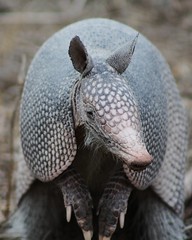
A fierce debate is in progress. Human slaughter or natural demise....
Giant beavers, oversized ground sloths, and huge armadillo-like creatures all disappeared within a couple of thousand years — a mere heartbeat in geological terms. Was it just hard living on cold ice or were humans to blame for this massive loss? Scholars hotly dispute whether or not we were solely responsible for these extinctions. We certainly played a role.
Significantly however, the disagreement is based on arguments about what effects the changing environment had on these animals, about the timing of human arrival in America, the possible speed and methods of human immigration down the two continents, and whether and when viable ice-free corridors existed down the center of North America; no one appears to be arguing that ancient peoples were technologically incapable of killing such large beasts in enormous numbers.
We know that isolated islands have housed game that thrive for a time and then disappear. The Queen Charolotte Islands, an archipelago of several hundred islands and islets, are just such a place - they housed grizzly bears some 13,600 years ago and while they no longer live in the region, we are left searching for clues as to their disappearance.
We also find evidence in caves of deer bones dating back 12,600 years, suggesting a post-glacial arrival and a date well before the arrival of Europeans, who were originally credited with their arrival.
Why did some of the larger game on the lush islands thrive for a time and then vanish altogether. Rapid environmental and geographical changes combined with more efficient hunting methods form part of the answer.
Human Slaughter or Natural Competition?




Comments